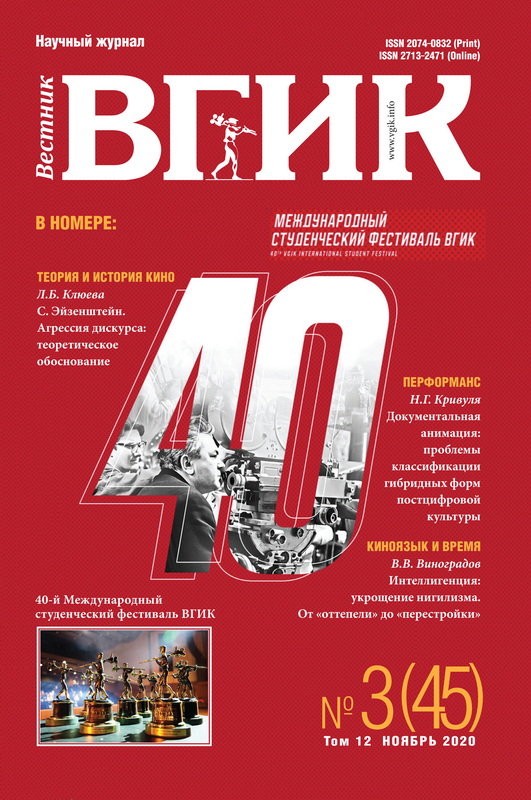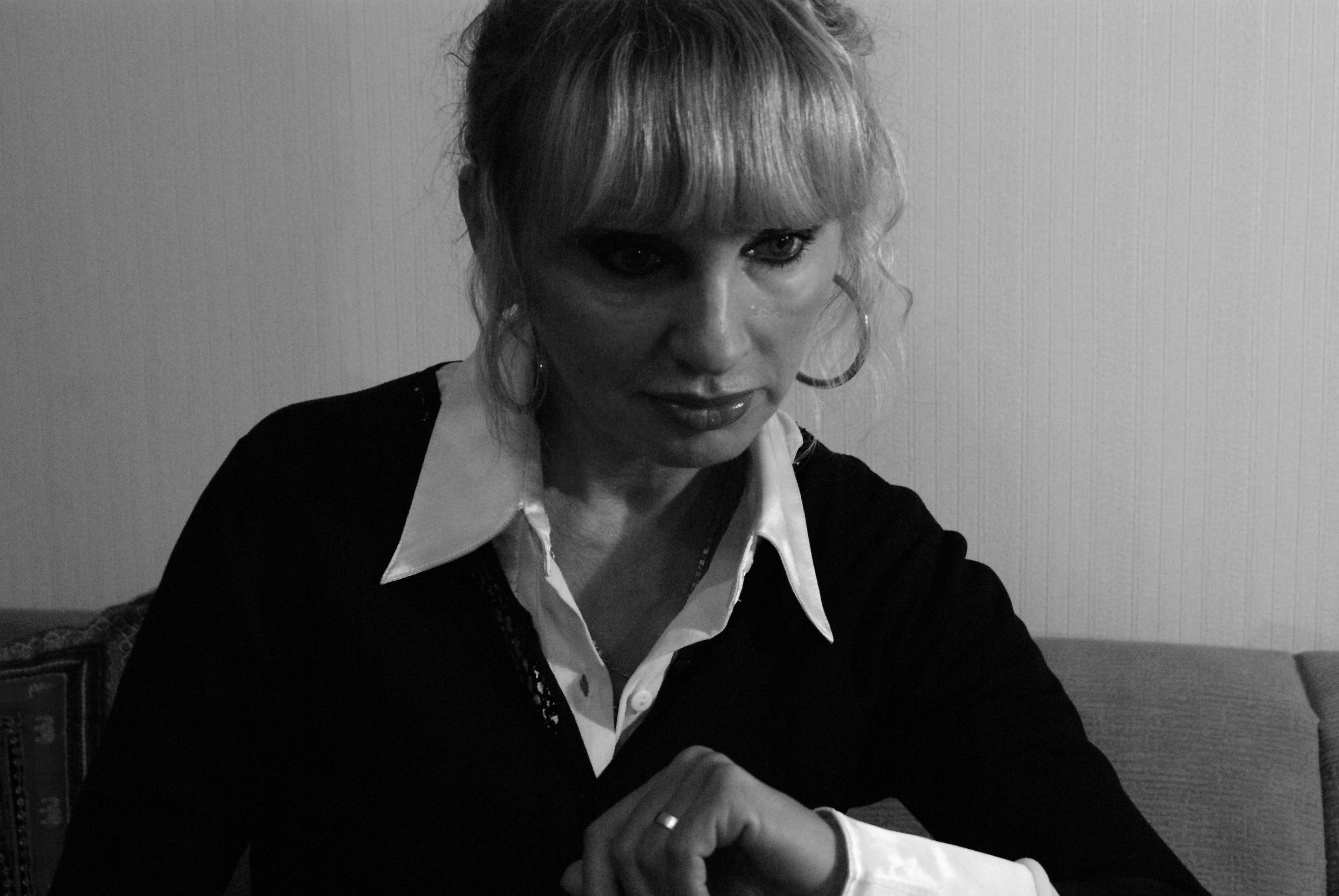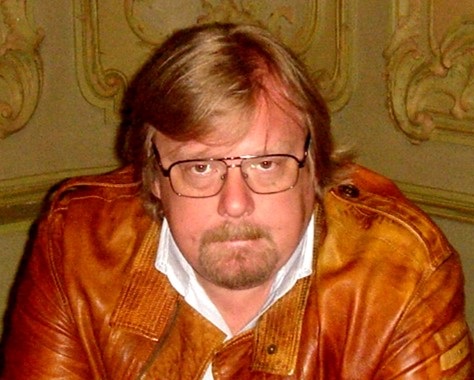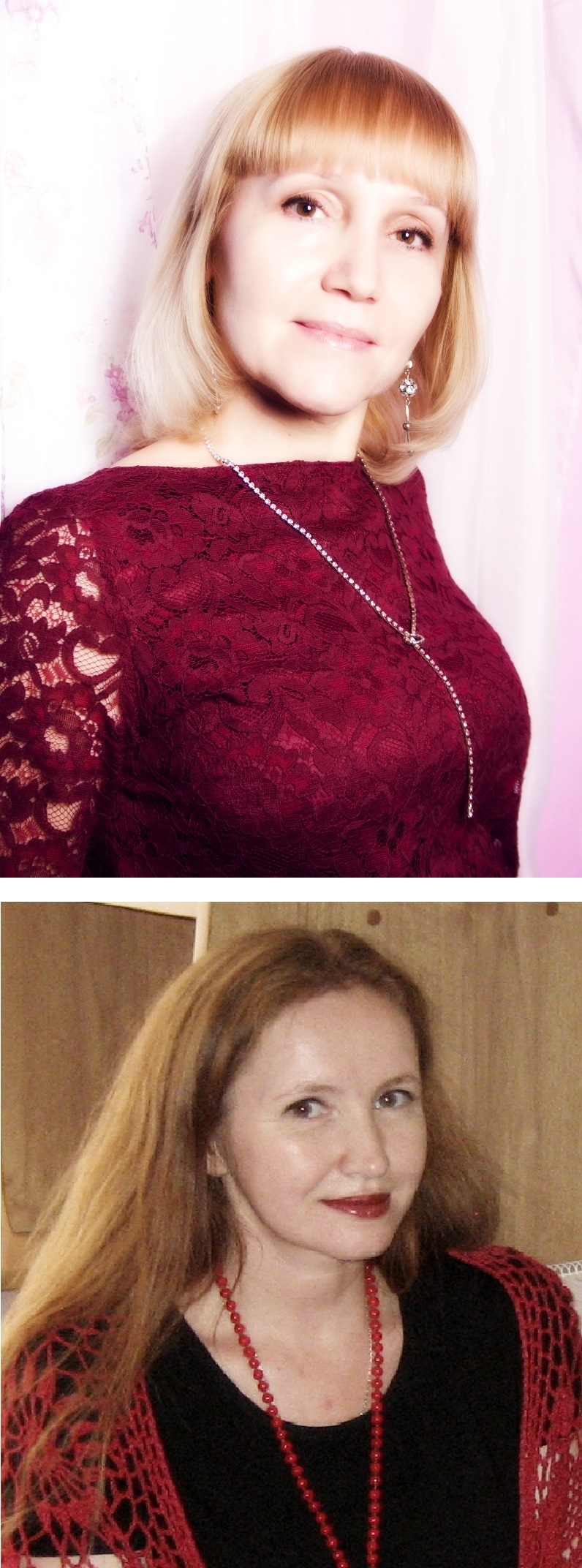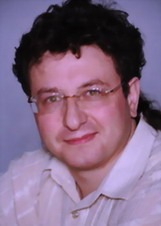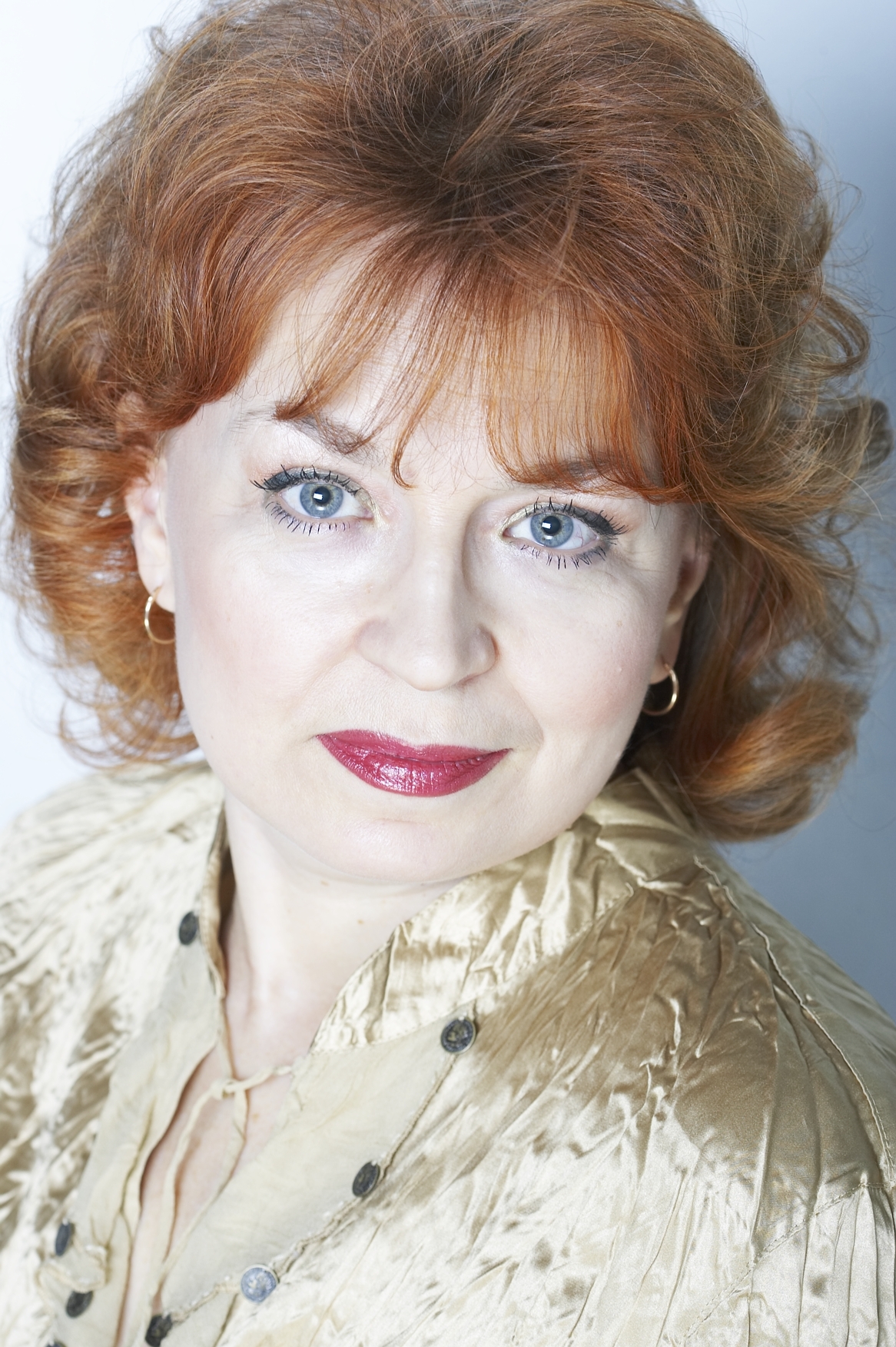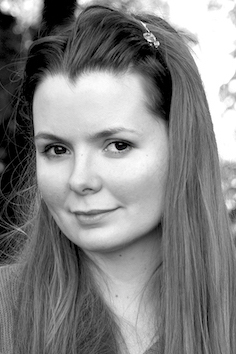卷 12, 编号 3 (2020)
- 年: 2020
- 文章: 15
- URL: https://journals.eco-vector.com/2074-0832/issue/view/1162
- DOI: https://doi.org/10.17816/VGIK123
完整期次
CHRONICLE IN DETAIL | CURRENT EVENTS
VGIK festival: virtual recognition
 6
6


THEORY AND HISTORY OF CINEMA | AUDIOVISUAL ARTS
S.Eisenstein. Aggression of Discourse: Theoretical Justification
摘要
The desire to write this work was the result of reflections on the features of “kinofilme” of the three major Directors of world cinema — , S.M.Eisenstein, Alexey Herman Sr., Michael Haneke. Moreover, the line of communication between them can be defined by the formula “aggression of discourse” or, in other words, the aggression of the Director's method.
The theoretical basis of the problem goes back to the ideas of S. Eisenstein, who put the problem of targeted impact of works of art on the viewer at the forefront of the creative process. Eisenstein used a special definition for this problem, namely — Grundproblem or the Main problem. Considering the impact of the main constituent of the entire creative process, Eisenstein sets the task of identifying and understanding a certain unit of measurement, as he defines it — the "atom" of artistic influence. In the case of film this smallest unit, the atom of the artistic influence will be “attraction”. In 1923, the famous article by S.M. Eisenstein “Montage of attractions” was published in the magazine “Lef ”. Here, in italics, he gives the first definition of the term “attraction” rom the perspective of the theater: “Attraction (in the context of the theater) will be every aggressive moment (theater), i.e., its every element exposing the viewer to sensual or psychological influence, experimentally calibrated and mathematically designed for certain emotional shocks of the recipient; in turn, they in total, are the only prerequisites making possible the perception by the viewer of the ideological side of the demonstrated product, its final ideological conclusion”. We can say that this thesis, which is the essence not only of the Director's article, but in a certain sense the core of his method prompted us the title of the work namely: “aggression of discourse”. And here a comment is necessary. First, we remove from the word "aggression” its inherent negative connotation and focus on one of the qualities of its impact, i.e. “inevitability”. Here, as we see it, is the key to the whole concept. Aggressive discourse means inevitable impact. And the language of this discourse consists of a series of “attractions” or a series of inevitably influencing elements. The question is how imminent is the impact? How does it relate to the will of the Director? How this impact is realized in the discourse? What is the role of the viewer in the whole process? In addition to the “Montage of attractions”, the article looks at other works by Eisenstein related to the problems of influence; it determines the special status of the viewer in the entire creative process accorded to him by the Director; it examines in detail Eisenstein's research in the field of the main components of the dialectics of the artistic image, namely: “progressive” (logical thinking) and “regressive” (early sensual thinking), which at the beginning of the creative process reveal their exceptional polarity, then in the process of in-depth and intense research turn into a bipolar unity, which is the essence of the artistic image ("the formula of duality»).
The features of the Director's discourse are studied and determined in the light of the goals and objectives set by Eisenstein. In a sense, the article initiates the formulation of the problem: how relevant today are those basic theoretical provisions that are stated in the “Method” by the great thinker and Director?
 8-28
8-28


Cinema Magic: Mask and Myth
摘要
2020 is the year of the 125th anniversary of cinema, which came into being thanks to the Lumiere brothers as a technical attraction. The article analyzes the process of the formation of cinema as a form of art and as a kind of medium, the magic of which lies in the psychological impact on the viewer, the ability to involve him in the audiovisual space. Already at the beginning of the 20th century, cinema acquires the status of the most popular art and retains this position in the digital era. The basis of its spectacularity is a synthesis of technology and creativity, masks of the “star” and myth.
Considering the peculiarities of cinematic magic from a historical perspective, the author proves that Georges Méliès was the first to master the magic of the screen, steering cinema along the path of spectacle. The first masks of the “stars” as screen brands (Andre Deed, Max Linder, Douglas Fairbanks, Mary Pickford, Harold Lloyd and Buster Keaton) contributed a lot to this process. Much credit for the development of cinema as an art form belongs to Charles Chaplin and his famous “Chapliniada”, which is based on the social mask of the “little man”, which Chaplin turned into a universal human image. The “star system” which nourished the Hollywood empire influenced the film aesthetics and the development of cinematic genres. An important role in this process was played by the “myth stars”, among whom Asta Nielsen, Rudolfo Valentino, Greta Garbo, Marlene Dietrich stand out in the history of cinema.
By addressing the problem “a star in Soviet style: a mask or a social type?” The author examines the ways of development of Russian cinema in its polemics with commercial Western cinema, proving that the synthesis of creativity and ideology made it possible for our filmmakers to create outstanding works of screen art in different periods.
 29-42
29-42


FILM LANGUAGE AND TIME | IMAGE GENESIS
The Intelligentsia: Taming Nihilism. From “Thaw” to “Perestroika”
摘要
This article is a fragment of a work devoted to the issues of figurative representation in Russian cinema. The article briefly analyzes the evolution of the scientist's image, from the period of the “thaw” to the beginning of “perestroika”. The author's theoretical approach is based on the definition of nihilism given by N.Berdyaev in his article “Russian Socialism and Nihilism”. According to the author of the article, one of the directions of the policy of the Soviet government in relation to the intelligentsia was to use the features of nihilism, which are the essence of the Russian and Soviet intelligentsia. Of course, this policy is reflected in the cinema. The article describes two stages in the cinema of the Soviet period: the “thaw” and “70s – early 80s”. Characterizing the image of a scientist in the era of the “thaw”, the author notes that this is a scientist who has ideals, who does not compromise – everything in the name of the goal, he won’t tolerate meanness and dishonesty.
The article traces the changes taking place in the representation of this image in national cinema over more than two decades. The author concludes that the lack of people who can seriously care about the public good leads to the fact that in the difficult historical period there were no champions capable of maintaining confidence in the reality of ideals in the state. Protecting society from moral decay, which was the main task of the intelligentsia, was removed from the agenda. The feeling of its own marginality, sectarianism, heresy, not only its habitual removal from the life of the state, but also its anti-state stance as a principle of behavior, all of it led to the fact that in the 90s., focused on themselves and their well-being as the material embodiment of what equaled the public good according to the understanding at the time, the intellectuals could not offer anything except another round of nihilism in relation to Soviet history and quickly left the historical scene and almost disappeared from the screens as a meaningful image.
 44-56
44-56


The Film “Stalker” by A.A.Tarkovsky as a Manifestation of F.M.Dostoevsky’s World Outlook
摘要
This article analyzes the process of transformation of “A Picnic on Roadside”, a science fiction novel written by the Strugatsky brothers, into Andrey Tarkovsky’s movie “Stalker”. Despite the fact that Tarkovsky himself said the sci-fi section of the film was no more that a strategic trigger that helped to reveal the key ethical conflicts, up to now, there has been no attempt to compare the film “Stalker” with the original novel in order to understand the director’s intention. This article aims to look into what made him choose the novel and how he turned it into a movie.
Tarkovsky found the shelter for souls and hope in “A Picnic on Roadside”. In other words, he found the psychological and existential clues that could be combined with material from Dostoyevsky’s works.
The stalker described by the Strugatsky brothers was a kind of predator selling mysterious things in the forbidden zone, whereas the stalker described by Tarkovsky functioned a priest who guides the lost or miserable souls to the sanctuary to realize their desire and hope.
Furthermore, the stalker’s attitude toward life in the movie incorporates Dostoyevsky himself who experienced Siberia and is reminiscent of both Raskolnikov from the novel “Crime and Punishment” and Myshkin, the main character of the novel “The Idiot”. Just like Sonia of “Crime and Punishment” and Myshkin of “The Idiot” discovered God through the image of the “holy fool”, so the stalker, his wife and daughter discover the fullness of God through their flaws.
This “kenosis” attribute is the basis of the fullness of Dostoevsky’s work, which inherits the spirit of the Russian Orthodoxy. In the final script, Tarkovsky transforms the “forbidden zone” into a sacred space. The path of the characters heading toward the “zone” is “the exploration of their human mind”. The “Stalker” is a philosophical meditation.
 57-67
57-67


Short Film: Genre Originality of Debuts
摘要
The articles analyses contemporary Russian short-length films. In the “Short Film and Cinematic Process”section, the shorts are compared to full-length films, revealing such basic typological features of shorts as greater freedom in choosing a subject, broad opportunities for experiments with the specific genre characteristics and with the selection of the means of expression, a shorter distance between the film and the viewer due to digital technologies and the availability of online movie platforms. In the section “Russian Short Films in the Context of World Trends”, the authors of the article compare Russian short films of recent years and their foreign counterparts and come to the conclusion that domestic films are chaster, their authors do not raise radical feminist issues, do not aim to shock the viewer by provocative social dramas. The section “Russian Short-length films: Quality Criteria”, substantiates the idea about a specific contribution of the best term and graduation works of students and recent graduates of the All-Russian State Institute of Cinematography named after S.Gerasimov to the modern achievements of domestic shorts. In the sections “Audience hits: the formula for success”, “Gender and family problems in Russian short-length films”, “Crime comedy as a critical aspect of the perception of reality” the authors undertake a case study of short films and outline the following problematic areas addressed by modern Russian short film
directors: growing up and choosing a life path, gender problems, anthropology of family and parenthood, interrogative rhetoric and new sentimentality, the search for national identity, critical and ironic aspects of the perception of reality. The article has a sufficient degree of relevance and scientific novelty, since modern Russian short films have not been the subject of special research until now.
 68-78
68-78


PERFORMANCE | ART OF PRESENTATION
Techniques for Representing the Author in Alexander Sokurov’s films
摘要
One of the features of A. Sokurov's art is the author's manifest subjectivation of the material. In addition to the implicit presence of the author evident in the choice of the idea, the main character, the entire artistic solution, the director explicitly manifests himself in films.
In this regard, both the degree and the quality of the author's presence in his own work are of interest. The focus of this study is the obviousness of the author's direct involvement in the very fabric, the structure of the film.
The main purpose of the work is to identify and study the methods of the author's self-representation. The article analyzes films united by the pronounced author's "presence": the so-called cycle of non-fiction “Elegies”, the films “Maria”, “Russian Ark” and “Francophonie”. This approach makes it possible to identify several basic techniques the director uses to represent the author's image. The first one is typical of Sokurov’s art and presupposes the author who becomes the narrator of the film and models the narrated construction into a subjective artistic image.
Another way of doing it, when the author acts as an interviewer, the latter is replaced by a silent interlocutor observing his hero. In this case, the director uses the principle of long-term observation, which allows him to see what is usually hidden behind words and external phenomena.
Perhaps, the very unique way is turning Sokurov himself into the main character of his own film. Here the maximum subjectivation is achieved: the author shares his thoughts, feelings, enters the frame, actively interacts with the characters, forcing them to violate the principle of the “fourth wall”. Sokurov even removes the figure of the actor and takes his place himself, in order to literally appeal directly to his viewer, lure him after with him.
Thus, this study allows us to reveal Sokurov's combination of documentary cinema, television broadcasting, first-person computer game technologies and augmented reality simulators, expanding the boundaries of filmic reality and the language of cinema.
 80-90
80-90


Evolution of Stunt Episodes in Fiction Films about the Great Patriotic War
摘要
Taking the same stunt episode in three film adaptations of the short story “The Dawns Are Quiet Here...”, which were made by S.I.Rostotsky (1972, USSR), M.Weining (2005, China — Russia) and R.F.Davletyarov (2015, Russia) as an example, the article studies the transformation of the film stunts in terms of their choreography.
The principal distinctive characteristics of each of these adaptations are specified. Particular emphasis is laid on the artistic value of stunt episodes as a means of creating the cinematic truth in Soviet (later Russian) films about the Great Patriotic War (1941–1945). The peculiarity of Russian stunt episodes in fiction war films is that a heroic exploit per se is a stunt. The heroism of the Soviet people in the Great Patriotic war meant above all overcoming, persistence and humanism. And the utmost manifestation of these qualities achieved by plastic expressive means is a stunt. The author assumes that every film stunt must have an intrinsic artistic side to it, which precisely complies with the narrative plotline while evoking a direct association with the plastic pattern of a particular character. The corresponding body of evidence is the result of an empirical method of analyzing the object in the temporal aspect (retrospection and prognosis).
Today Russian films about the Great Patriotic War (1941–1945) and their predecessors, Soviet movies — which may be considered a gold standard of the use stunts — can be looked upon as a cinematic paragon of presenting the truth about the deadliest war of the twentieth century both in historic reenactment and artistic retrospection.
 91-101
91-101


Animated Documentary: Problems of Classifying the Hybrid Forms of Post-Digital Culture
摘要
Animadoc has become a phenomenon of post-digital culture. Such films are created by means of animation, but their stories are based on documents, facts, and real events. Synthetics, the use of images of varying degrees of iconic isomorphism are typical for animadoc. The problem of classifying animated documentary arises from its hybrid nature, resulting from the combination of documentary content and fictional form.
For the first time, there are three main tendencies of research in the sphere of animated documentary based on the analysis of the corpus of scientific texts. The first tendency views the animated documentary as a genre or form of performing documentaries. The advent of digital technologies brought about a fundamentally new understanding of documentary, rethinking the concept of authenticity, reality, screen document. Subjective and performance tendencies are becoming more prominent in documentaries. This makes it possible to legalize documentary animation with its reconstructive, reflective, and interpretive constituents.
The second tendency looks upon animadoc as a genre or a new kind of animation. It expands the thematic boundaries and visual means of animation. It goes beyond its traditional areas. Animation is no longer considered a tool intended solely for the presentation of fantastic and fairy-tale worlds and the space of children's imagination.
The third trend in research considers animated documentary a hybrid, experimental form of supersensory visuality, representing invisible areas of reality, as an optical practice and a form of alternative vision, which instead of the surface focuses on the "folds", the zones of concealment and ellipsis.
This tendency makes no emphasis on the specific and genre differences. What matters is how animadoc builds new forms of communication and becomes a new type of observation. The socializing and therapeutic functions of animadoc are emphasized, and it begins to be understood as a form of screen media of post-digital culture.
 102-118
102-118


SCREEN CULTURE | CULTURAL STUDIES. PHILOSOPHY
Is Aesthetics a Metatheory in Relation to Art Criticism?
摘要
This article addresses the comparative analysis of aesthetics and art criticism, as well as describes their special aspects and objectives, considers different viewpoints on the interrelation of these areas – the ideas of Beardsley and R.Barthes in particular. The article further develops Barthes’ ideas concerning radical changes that have taken place in contemporary art criticism. In particular it deals with the assumption that art criticism has no relation to truth. Thus, the viewpoint of Beardsley, who insists that aesthetics is a metatheory in regards to art criticism, is subjected to argumentative scrutiny. The article analyzes the idea that art criticism must be carried out on the basis of aesthetic values only, without taking into account other social circumstances of creation and functioning of any work of art. A work of art may have value (cognitive, moral etc.) outside aesthetic categories and it can be assessed from different points of view. According to Beardsley, objective aesthetic arguments may be reduced to three universal canons: unity, complexity and intensity, – a thesis, which is also subjected to argumentative scrutiny. It is also stated that criticism cannot exist outside of ideology, which is proved by the entire history of its development. The article also describes the evolution art criticism and demonstrates that art critics can switch from the standpoint of artists’ defense to that of the defense of public interests. The article puts forward the idea that aesthetics as well as art criticism are drifting towards literary works rather than philosophy. At the same time aesthetic, unlike art criticism, does not cease to be a science, although imprecise and inexact.
 120-131
120-131


READING-ROOM | BOOK SHELF
Library VGIK
 132
132


TELEVISION | DIGITAL ENVIRONMENT
Modern Forms of Capturing Reality in the Format of Video Hosting
摘要
This study examines the impact of video hosting on the process of creating a publicly available record of people's lives. The popular public network Tik Tok is a platform for creating and publishing short videos. Users communicate by creating and posting their own video material. It turns out to be a difficult task to single out meaningful video content from the whole mass of a very bizarre, and sometimes farcical spectacle that has filled the Internet space. Nevertheless, from the total mass of video messages, we can crystallize single authors, whose videos offer evidence of the creator’s interest in the lifestyle of an ordinary man, his workdays, life events, videos which seem authentic and sincere, deal with significant social issues. We observe the of convergence of the creative and technical sides of the filming processes, when the authors of the video, who also appear as characters, camera operators, editors all in one, provide video content in the public network space.
The means of interactive communication with the audience contributes to the emergence of a sense of empathy for the author, who presents reality through the conceptualization of his own experience. The example of the videos by a teenage girl who found herself in an orphanage and whose means of communication with the outside world was a mobile phone camera, demonstrate the demand for the Tik Tok video hosting platform by the younger generation. The author of the video messages, capturing the reality in the form of a confessional monologue with the viewer, finds strong support from the audience. At festival venues, nominations in the category of videos by amateur users of video platforms are becoming increasingly common, thus the video hosting platform is considered as an accessible digital environment offering the possibility to present the issues of concern for an author. The emergence of Internet platforms for the free viewing of the accumulated cultural heritage of documentary films will make it possible to popularize interest in the image of a real hero, whose spiritual and moral values will contribute to the meaningful recording of reality.
 134-144
134-144


XPOHИКА В ДЕТАЛЯХ | АКТУАЛЬНОЕ СОБЫТИЕ
40th International Student Festival of VGIK
摘要
В октябре-ноябре 2020 года прошел 40 Международный студенческий фестиваль ВГИК. Организаторы фестиваля – ФГБОУ ВО «Всероссийский государственный институт кинематографии имени С.А.Герасимова» (ВГИК) и Продюсерский центр «ВГИК-Дебют».
 145-151
145-151


SUMMARY | PRESENTATION OF AUTHORS
Summary
摘要
Краткое представление авторов и содержания статей номера
 152-157
152-157


RECOMMENDATIONS AUTHORS
Recommendations for authors
 158-160
158-160










